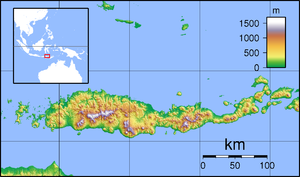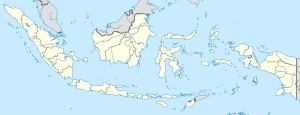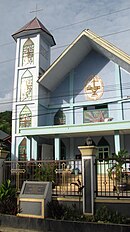
Flores is one of the Lesser Sunda Islands, a group of islands in the eastern half of Indonesia. Administratively, it forms the largest island in the East Nusa Tenggara Province. Including Komodo and Rinca islands off its west coast, the land area is 14,731.67 km2, and the population was 1,878,875 in the 2020 Census ; the official estimate as of mid-2023 was 1,962,405. The largest towns are Maumere and Ende. The name Flores is of Portuguese origin, meaning "Flowers".

Sumbawa is an Indonesian island, located in the middle of the Lesser Sunda Islands chain, with Lombok to the west, Flores to the east, and Sumba further to the southeast. Along with Lombok, it forms the province of West Nusa Tenggara, but there have been plans by the Indonesian government to split the island off into a separate province. Traditionally, the island is known as the source of sappanwood, as well as honey and sandalwood. Its savanna-like climate and vast grasslands are used to breed horses and cattle, as well as to hunt deer.

Alor is the largest island in the Alor Archipelago and is one of the 92 officially listed outlying islands of Indonesia. It is located at the eastern Lesser Sunda Islands that runs through southeastern Indonesia, which from the west include such islands as Bali, Lombok, Sumbawa, Komodo, and Flores.

East Nusa Tenggara is the southernmost province of Indonesia. It comprises the eastern portion of the Lesser Sunda Islands, facing the Indian Ocean in the south and the Flores Sea in the north. It consists of more than 500 islands, with the largest ones being Sumba, Flores, and the western part of Timor; the latter shares a land border with the separate nation of East Timor. The province is subdivided into twenty-one regencies and the regency-level city of Kupang, which is the capital and largest city.

Komodo National Park is a national park in Indonesia located within the Lesser Sunda Islands in the border region between the provinces of East Nusa Tenggara and West Nusa Tenggara. The park includes the three larger islands Komodo, Padar and Rinca, and 26 smaller ones, with a total area of 1,733 km2. The national park was founded in 1980 to protect the Komodo dragon, the world's largest lizard. Later it was dedicated to protecting other species, including marine species. In 1991 the national park was declared a UNESCO World Heritage Site.

Komodo is one of the 17,508 islands that comprise the Republic of Indonesia. It is particularly notable as the habitat of the Komodo dragon, the largest lizard on Earth, which is named after the island. Komodo Island has a surface area of 291 square kilometres, and had a human population of about 1,800 in 2020.

Tourism in Indonesia is an important component of the Indonesian economy as well as a significant source of its foreign exchange revenues. Indonesia was ranked at 20th in the world tourist Industry in 2017, also ranked as the ninth-fastest growing tourist sector in the world, the third-fastest growing in Asia and fastest-growing in Southeast Asia. In 2018, Denpasar, Jakarta and Batam are among of 10 cities in the world with fastest growth in tourism, 32.7, 29.2 and 23.3 percent respectively. The tourism sector ranked as the 4th largest among goods and services export sectors.

Rinca is a small island near Komodo and Flores island, East Nusa Tenggara, Indonesia, within the West Manggarai Regency. It is one of the three largest islands included in Komodo National Park. The island is famous for Komodo dragons, giant lizards that can measure up to 3 metres (9.8 ft) long. Rinca is also populated with many other species such as wild pigs, buffalos and many birds.
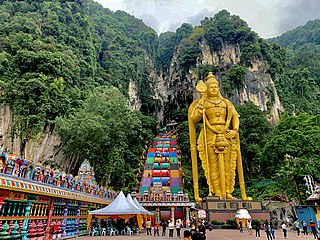
Tourism in Malaysia is a major industry and contributor to the Malaysian economy. Malaysia was once ranked 9th in the world for tourist arrivals. In 2017, the Travel and Tourism Competitiveness Report ranked Malaysia 26 out of 141 countries using its Travel & Tourism Competitiveness Index (TTCI) which measures the various components and policies of a country that are in place to allow for the sustainable development of its travel and tourism sectors.

Sail Indonesia is a series of sailing and other events for yachts conducted each year in Indonesia. The events are organised by Yayasan Cinta Bahari Indonesia (YCBI) and supported by the high-profile tourist destinations to international yachtsmen and women with a view to expanding the tourism potential and raising awareness of the region as well as introducing visitors to natural and cultural features of the Indonesian archipelago that they might otherwise not visit.

Komodo International Airport is an airport near the town of Labuan Bajo on the island of Flores in East Nusa Tenggara province, Indonesia. The airport's name comes from Labuan Bajo's status as a departure point for tours to the nearby Komodo National Park, home of the Komodo dragon.

The Sape Strait or Sapie Strait is a strait connecting the Flores Sea to the Sumba Strait. It separates the islands of Sumbawa and Komodo. It joins the Indonesian provinces of West Nusa Tenggara and East Nusa Tenggara.

West Manggarai Regency is one of the eight regencies which comprise the island of Flores, located in the province of East Nusa Tenggara in Indonesia. The Regency was created on 25 February 2003 by the separation off of the western districts from Manggarai Regency. It covers a land area of 3,141.47 km2, and had a population of 221,703 at the 2010 census, rising to 251,689 at the 2015 Intermediate census and to 256,317 at the 2020 census. The official estimate as at mid 2023 was 270,917. The regency's capital is the town of Labuan Bajo.
Mirror stone cave is a cave or tunnel located in a rock hill in West Manggarai, Flores, East Nusa Tenggara, Indonesia, just a few kilometers to the east of the town of Labuan Bajo.
The Komodo Biosphere Reserve and National Park is situated between Flores and Sumbawa in Indonesia. It is renowned for its population of about 5,000 giant lizards, called 'Komodo dragons'. They exist nowhere else in the world and are of significant interest to scientists studying the theory of evolution.
Tour de Flores is a multi-day cycling race on the Indonesian island of Flores. It is part of UCI Asia Tour in category 2.2. Aside from Larantuka, Labuan Bajo and Komodo National Park, the cyclists race along natural and cultural wonders of Flores Island such as the tricolor lake on Mt. Kelimutu, the megalithic village of Bena, and the exiled house of Indonesia’s first president, Sukarno in Ende. Tour de Flores had become an annual international cycling event since 2016.

Padar, also known as Pada, is a small island located between Komodo and Rinca islands within Komodo archipelago, administered under the West Manggarai Regency, East Nusa Tenggara, Indonesia. It is the third largest island part of Komodo National Park.
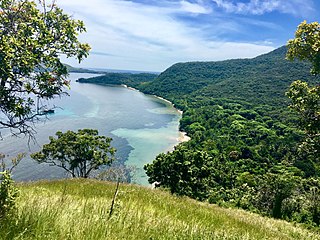
The Kokotuku Peninsula is a 986 hectare tropical land mass located 20 kilometers north of the city of Labuan Bajo, West Manggarai, Flores NTT, Indonesia. The West Flores-Komodo region is a UNESCO World Heritage Site, and is considered one of the Seven Wonders of the Natural World.
Komodo is a district in the regency of West Manggarai, East Nusa Tenggara, Indonesia.

